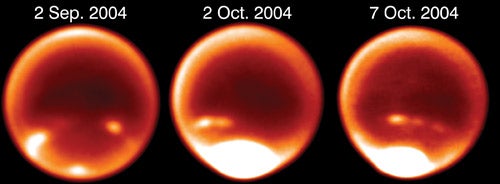Intermittent clouds on Saturn’s moon Titan are the results of geologic activity on the surface, say researchers. While planetary scientists have long suspected this, recent observations suggest surface features, either cracks in the moon’s crust or ice volcanoes, are spewing methane into the atmosphere. These results potentially answer a longtime question about how Titan replenishes its abundant methane, which the Sun’s ultraviolet rays should have destroyed billions of years ago.
Henry G. Roe, a postdoctoral researcher, and Michael E. Brown, both of Caltech used the adaptive optics on the twin 10-meter Keck telescopes and the 8-meter Gemini North Telescope atop Mauna Kea in Hawaii to observe Titan on 82 nights over the course of 2 years. (Adaptive optics compensate for blurring caused by Earth’s atmosphere.) Their observations identify a region that may be feeding the gas into the moon’s atmosphere. The rising humidity results in localized cloud formation, just as on Earth.
images were taken at the W.M. Keck Observatory’s 10-meter telescope in a
filter that probes only down to the clouds and does not see the surface.
The global stratospheric haze layer is visible all over the planet. Along
with the southern hemisphere mid-latitude clouds, in September 2004 there was the usual small cloud near Titan’s south pole and in October 2004 a massive storm was located near the south pole.
Their intermittent appearance taken with their localized geography led Roe and Brown to conclude something on the surface was to blame. “We have several observations where on one night, we don’t see a cloud, the next night we do, and the following night it is gone,” says Roe. This pattern rules out other possible causes, most notably atmospheric convection.
While the team has not identified any specific surface feature as the source, Roe and Brown think whatever it is may be common. “We think there are numerous sources all over the surface, of varying size, but most below the size that we could see with our instruments,” Brown comments. The results are published in the October 21 issue of the journal Science.










